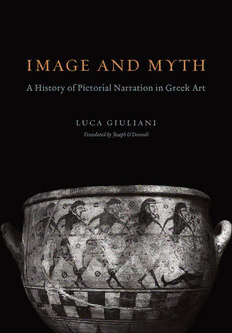
Image and Myth: A History of Pictorial Narration in Greek Art PDF
Preview Image and Myth: A History of Pictorial Narration in Greek Art
Image and Myth Image and Myth A History of Pictorial Narration in Greek Art LUCA GIULIANI Translated by Joseph O’Donnell University of Chicago Press Chicago and London Luca Giuliani is the Rector of the Institute for Advanced Study in Berlin and professor of classical archaeology at the Humboldt University of Berlin. Joseph O’Donnell is a professional translator based in Berlin. (cid:2) e University of Chicago Press, Chicago 60637 (cid:2) e University of Chicago Press, Ltd., London English translation © 2013 by (cid:2) e University of Chicago All rights reserved. Published 2013. Printed in the United States of America (cid:2) e translation of this work was funded by Geisteswissenscha(cid:3) en International — Translation Funding for the Humanities and Social Sciences from Germany, a joint initiative of the Fritz (cid:2) yssen Foundation, (cid:2) e German Federal Foreign Offi ce, the collecting society VG WORT and the Börsenverein des Deutschen Buchhandels (German Publishers & Booksellers Association). 22 21 20 19 18 17 16 15 14 13 1 2 3 4 5 isbn-13: 978-0-226-29765-1 (cloth) isbn-13: 978-0-226-02590-2 Originally published in German as Bild und Mythos: Geschichte der Bilderzählung in der griechischen kunst. © Verlag C.H. Beck oHG, München 2003. Library of Congress Cataloging-in-Publication Data Giuliani, Luca. [Bild und Mythos. English] Image and myth : a history of pictorial narration in Greek art / Luca Giuliani ; translated by Joseph O’Donnell. pages ; cm Includes bibliographical references and index. isbn 978-0-226-29765-1 (cloth : alkaline paper) 1. Art, Greek—(cid:2) emes, motives. 2. Narrative art—Greece. 3. Mythology, Greek, in art. 4. Vase-painting, Greek. I. O’Donnell, Joseph, 1960 September 4–, translator. II. Title. n5633.g48613 2013 709.38—dc23 2012038002 (cid:2) is paper meets the requirements of ansi/niso z39.48-1992 (Permanence of Paper). Contents Preface: (cid:2) e Pictorial Deluge and the Study of Visual Culture ix 1 Images and Texts Compared: A Diagnosis of Contrasts 1 Revisiting Lessing’s Laocoon 1 Taking Lessing beyond Lessing 3 2 Images of the World: (cid:2) e Eighth Century 19 (cid:2) e Shield of Achilles: Description and Narration 19 Fighting Lions 26 Seafarer’s Farewell 32 Siamese Twins 35 Aristocratic Life and Aristocratic Death 37 Warriors to Sea 44 3 (cid:2) e Advent of Pictorial Narratives in the Seventh Century 53 (cid:2) e Horse on Wheels 53 Polyphemos, the Defenseless Giant 70 Epic or Folktale? 78 v vi Contents 4 Playing with Writing in the Eighth, Seventh, and Sixth Centuries 89 Painters Learn to Write 89 Name Inscriptions Confi rming Narrative Content 93 Name Inscriptions Generating Narrative Content 97 Everyman’s Armor: Achilles’ Armor 105 Kleitias and the Muses 110 5 Directing the Gaze in the Sixth and Fi(cid:3) h Centuries 131 Polyphemos Again: (cid:2) e Synchronization of Narrative Images 131 Hektor’s Corpse: (cid:2) e Surprise at Dinner 139 (cid:2) e Hero and the Sorceress: Moments of Suspense 156 (cid:2) e Murder of Priam: Unparalleled Barbarity 169 (cid:2) e Fall of Troy: Combining Multiple Scenes 175 Victor and Vanquished: (cid:2) e Limits of Narration and the Possibilities of Description 185 6 Images in the Pull of Text: From the Fi(cid:3) h to the Fourth Century 195 Achilles’ Wrath and Achilles’ Lyre 195 From Oraliture to Literature: (cid:2) e Emergence of a Culture of Reading 207 Hastening Furies: Sleeping Furies 212 7 Pictures for Readers: (cid:2) e Birth of the Illustration in the Second Century 225 Splendor and Misery of an Odyssey Picture Cycle 225 (cid:2) e Triumph of Texts and the Fidelity of Images 234 8 Looking Back: Pitfalls and Nodes 243 Appendix Excursus 1: On the Interpretation of the (cid:2) eseus and Ariadne Scene on the Kleitias Krater 255 Excursus 2: On the Reconstruction of the Brygos Painter’s Kirke Cup (Athens, Acr. 293) 259 Notes 263 Bibliography 309 Name and Subject Index 329 Index of Ancient Greek Artworks 333 De toute image, on peut et on doit parler; mais l’image elle-même ne le peut. —R. Debray 1992, 58 We can never understand a picture unless we grasp the ways in which it shows what cannot be seen. One thing that cannot be seen in an illusionistic picture [ . . . ] is precisely its own artifi ciality. —W. Mitchell 1986, 39 PREFACE (cid:2) e Pictorial Deluge and the Study of Visual Culture For some time now, critics of contemporary culture have been warning us of an inexorably rising tide of imagery and its pernicious consequences. In their view, the spoken and wri(cid:14) en word is about to relinquish its traditional preeminence to the image: homo loquens et audiens is on the verge of becoming homo videns. Moreover, they argue, this shi(cid:3) is threatening to extinguish an essential—per- haps the decisive—foundation of human rationality. (cid:2) e higher cortical centers responsible for the conscious processing of information are for the most part not involved in visual perception. And the fact that images are not subject to control by our consciousness makes it all the easier for them to infi ltrate and undermine our capacity for reason. Without our being aware of it, they become fi xed in our minds and exercise a suggestiveness that shapes the way we think and feel.1 It is diffi cult to argue with the claim that in our media-pervaded environ- ment pictures are playing an increasingly dominant role. But can we conclude from this that we are witnessing a hegemonic transition from the word to the image and that the power of images is threatening to erode the very foundations of our capacity for reason? (cid:2) e debate about the role of images in the media is certainly not a new one and can be traced back to the advent of press photography more than one hun- dred years ago.2 Photographs fi rst began appearing in illustrated journals around the middle of the nineteenth century. However, it was only in 1880 that the new technique of hal(cid:3) one printing made it possible to reproduce p hotographic ix
